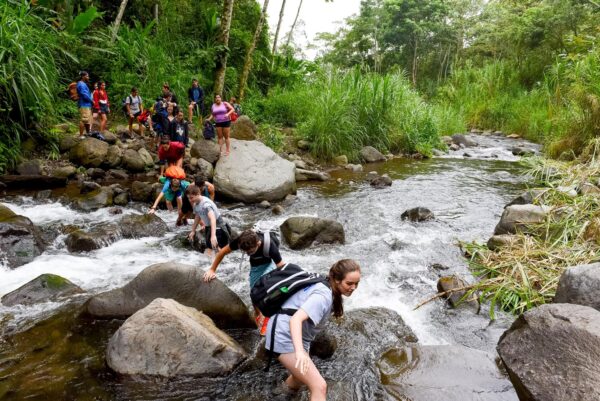
Students in Costa Rica enjoy the world as their classroom as they explore and learn from incredible local scenery.
While all this talk of getting college credit while adventuring around the world sounds amazing (and it is!), it might be hard to imagine how that actually translates into real day-to-day life…
So join us and get a glimpse into the program as we ride along with our participants through a day in the life in Costa Rica!
MORNING
Everyone is relieved and surprised to wake up to the sound of rain. Rain means a short respite from the heat and sticky humidity of La Fortuna, plus an opportunity to enjoy the incredible post-rain lushness of the surrounding rainforest.
And morning rain is a rare treat! The sound of rain fall is faint compared to the chorus of croaking frogs and singing birds, though. That’s one of the best parts of staying in the base house– it’s located on a private wildlife reserve where there are so many animals, plants, and trails to discover.
Aside from the incredible access to nature, the house also features a pool, soccer field, and foosball and ping pong tables. Not to mention it offers incredible views of the massive Arenal Volcano, a critical example of how Costa Rica uses natural ecosystems to source clean, geothermal energy.
The smell of fragrant spices frying in soybean oil motivates students to get up out of bed and head over to the dining room. They enjoy a delicious typical breakfast of gallo pinto (rice and beans), accompanied by eggs and tropical fruit like pineapple and papaya.
After scarfing down all that goodness, everyone’s ready to get started with today’s class. Class takes place in an outdoor, open classroom where students can feel the breeze and admire the scenery. The occasional toucan or sloth popping in is always a funny and welcome interruption!
Students dive into their International Development coursework and today’s discussion centers around the potential benefits and harms that tourism can bring to a region. The case study? The city they have been staying in, La Fortuna, where the expansion of tourism has led to the development of environmentally responsible, locally owned businesses. Students will get a chance to see one of these businesses in action later this afternoon.
After class wraps up, students have the opportunity to spend some free time as they wish. Everyone loves this time of day since it means more chances to explore the surrounding town and practice Spanish with friendly locals. Some students stay around the neighborhood to enjoy the trails, grab a snack from the local corner store, or take a dip in the river. Others choose to grab a coffee or walk around in the downtown area which is just a few minutes ride away.
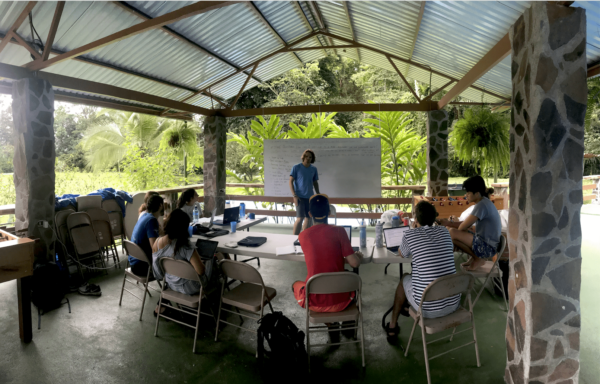
In Costa Rica, students enjoy class with a view!
AFTERNOON
Today’s lunch is a special treat. The group is greeted at Finca Don Juan (Juan’s Farm), an organic educational farm where visitors are taught about indigenous edible and medicinal plants. Students will get to participate in all aspects of preparing their lunch, from learning about the plants and picking the fruit to practicing traditional methods of cooking.
As the group walks around the gorgeous property, they are introduced to plants of all sorts: typical fruits like sugar cane and passion fruit, the national staple yucca root, and tons of herbs used as remedies for bad digestion, flu, body pains and more. The tour guide also explains how the farm’s electricity is actually produced using gas from animal excrement.
Students get their hands dirty as they help to plant yucca roots and pick the leaves and fruit that will be cooked as part of the lunch.
Up next? Cooking! The locals demonstrate how to make fresh tortillas and empanadas out of corn. While watching the cooking process, students learn about the cultural significance of tortillas and corn products. Corn is one of the most prevalent crops in Costa Rica and tortillas represent how Costa Ricans live in harmony with the environment by learning to use low-cost, local materials in creative ways.
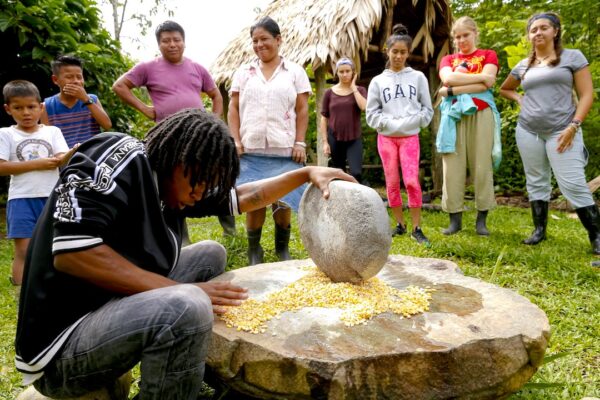
Students love learning from locals about how to turn local crops into delicious traditional foods!
Everyone’s mouths water as they watch the maise flour dough get rolled into balls, slapped into flat tortillas and put on the fire. The smell is intoxicating and they are ready to dig in!
The spread certainly doesn’t disappoint! The group enjoys different types of picadillo (cooked chopped vegetable dishes), plantain and cheese empanadas, salad, and star fruit juice (which the students picked and made themselves!).
Over lunch, some students chat with the guide about how much they’ve been loving the local styles of music. Eager to share his lively culture, the guide invites everyone to join in for an impromptu dance class! This is a beautiful example of Costa Rican culture; the country is known for its people’s warmth and desire to help and connect with everyone, even strangers. Dance is huge here and locals love to move to the rhythmic salsa, cumbia and merengue styles. The students crack up as they try to follow their new friend’s slick moves.
After a lively and eye-opening afternoon, the cohort heads back to the base house feeling inspired to incorporate more environmental awareness (and dance!) into their own lives.
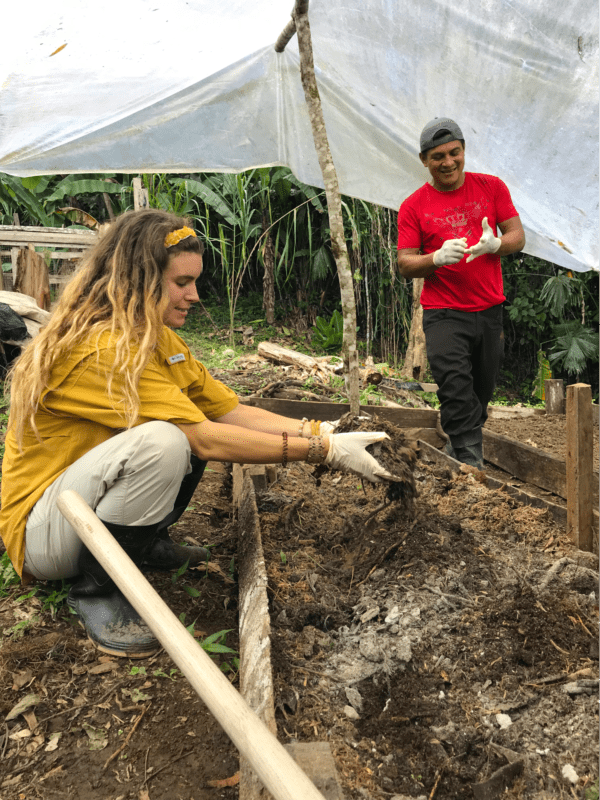
Anyone else love learning by doing?! Students aren’t afraid to get their hands dirty while learning about sustainable agriculture and native crops.
EVENING
When students get back to the house, they split up into groups to debrief about the day. Program leaders help students spend time reflecting intentionally; they thoughtfully integrate all they are seeing in and out of the classroom and work on personal development, group dynamics, and college preparedness. Today, the groups talk about what they learned at the farm and brainstorm what new ideas they can bring back home with them.
As evening rolls around and the temperature drops, it’s the perfect chance to enjoy a short hike and dip in the nearby hot springs. It’s an amazing way to relax after a packed day and students leave feeling totally blissed out.
Dinner is at home, made by the talented house chef Don Eric. One of the best parts of the semester is getting to know all of the wonderful staff, and students love catching up with Don Eric about his day and learning more about his family and culture. Everyone chows down on some tasty and fresh chifrijo, a dish of rice, beans and pork with diced tomato, lemon and onion. Don Eric’s cooking will definitely be missed when the semester ends!
After dinner, students have the chance to do some homework, talk with their families, and hang out. Because teachers actually live in close proximity to students, they often offer up this time to answer any questions that came up in class.
Then it’s lights out so that students will be energized for another amazing day tomorrow!
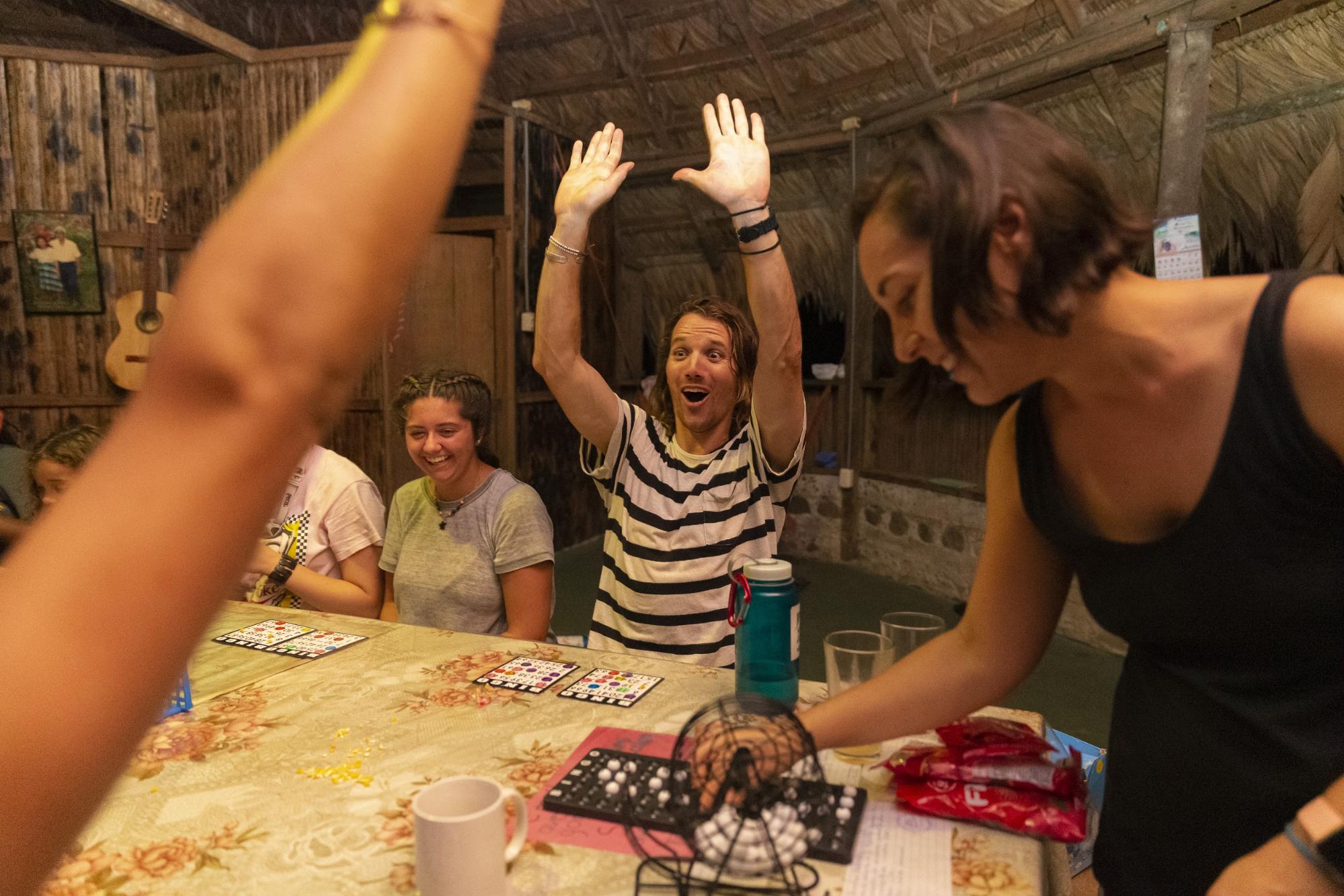
Verto cohorts love game night! When you travel and live with your peers and program leaders, every hour of every day becomes an opportunity to build incredible memories together.
WHAT’S NEXT?
Everyone is looking forward to their day trip to Rio Celeste where they will visit the indigenous Maleku community. There, they will learn about the Maleku’s tribal traditions and way of life and enjoy a hike to one of the country’s most stunning, turquoise waterfalls.
With more adventures like zip lining, windsurfing, and white water rafting coming up, there’s so much to look forward to!
Thanks for joining us for a Day in the Life in Costa Rica, where every day is programmed intentionally to give students a hands-on education they could never have in a typical college classroom.
At Verto, we want YOU to find the perfect post-high school plans for YOU. We’d love to help you plan for an epic start to college with a semester or year abroad. Reach out to our team to learn more!

